 Theory Of B Field Antenna Radiation
Theory Of B Field Antenna Radiation(Still in progress - checking the maths still)
Or return To Magnetic B Field Antenna
This analysis will consider a
square loop antenna, as an approximation to a circular loop, since square (or
rectangular) antennas are often more convenient to fabricate, especially on a
PCB substrate. Each side segment will have an equal length L and
an ac current iac will be
flowing in the loop, as shown below. The area A of the loop will
therefore be
![]() .
.
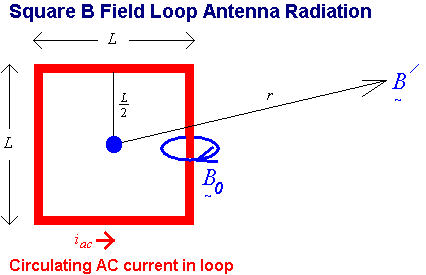
We first need to calculate the
magnitude of the magnetic field B
at a distance d from the loop, given that this current iac
is circulating in the loop. Providing d >> L
the magnetic field will be constant over a circumference defined by the distance
d, in the plane of the loop. We will consider the simplest case
where the field is estimated at a position perpendicular to one side of the
loop.
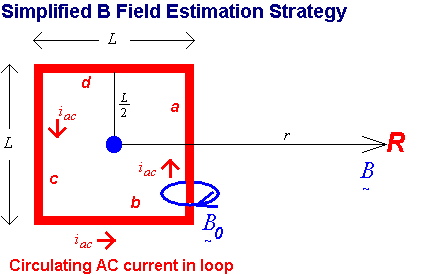
We note that the loop’ side
segments a and c
are perpendicular to the direction defined by r, and therefore
contribute magnetic B field
components at position R. The other
side segments b and d
are not perpendicular, and so their magnetic contribution diminishes as
![]() . Also note that the current iac
flowing in side a is equal and
opposite to that flowing in side segment c,
so that the total magnetic field at position R
is equal to the difference caused by this opposition. From Biot’s law applied
to a short wire length,
. Also note that the current iac
flowing in side a is equal and
opposite to that flowing in side segment c,
so that the total magnetic field at position R
is equal to the difference caused by this opposition. From Biot’s law applied
to a short wire length,
![]() ...(1)
...(1)
It follows that the combined
magnetic field B at point Y
must be the difference
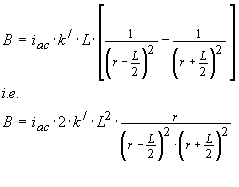 ...(2)
...(2)
Given that we will assume that the
loop dimensions L are small compared to the remote point R
at distance r, we will approximate
![]() . This suggests that
. This suggests that
![]() ...(3)
...(3)
From electromagnetic theory we have a relationship between radiated energy density u and the corresponding electrostatic and magnetic fields E and B given by,
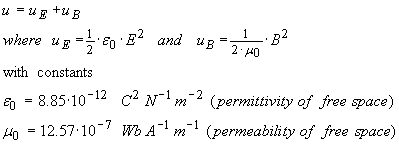 ...(4)
...(4)
This implies that the magnetic energy density uB component in the plane of the loop at a distance r caused by iac is,
 ...(5)
...(5)
This energy occupies a volume in
space determined by an area A and a forward distance determined by
the speed of light c at a unity time dt. The magnetic
intensity sB
is equal to the rate at which this energy passes through this imaginary volume
in space, i.e.
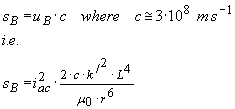 ...(6)
...(6)
The magnetic field strength Bf at an angular position f
above or below the plane of the loop will have a cosine reduction given by
![]() ...(7)
...(7)
It follows immediately that the magnetic
intensity sB
must have a cosine-squared variation
 ...(8)
...(8)
Expressed graphically as,
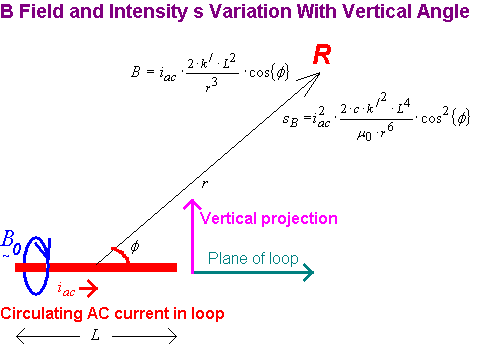
The total magnetic intensity SB
generated by the loop can be found by integrating sB
over the surface of a sphere with radius r. In free space, the
total energy must of course remain constant for any value of R,
based on conservation of energy. The magnetic
intensity will reduce with distance, but the combined magnetic
and electrostatic intensity
integrated over any closed surface must remain constant. The surface
area of a sphere is
![]() ...(9)
...(9)
If the magnetic intensity sB
was constant over the surface of this imaginary sphere, then the total
magnetic energy, or power EB
attributed to this magnetic component would just be
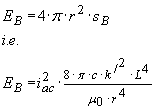 ...(10)
...(10)
We note that the magnetic
intensity is constant in the plane of the loop but falls of at
the square of the cosine of the angle above and below this plane. If we
performed the integration we would find that the actual integrated energy would
become one half the value compared to a constant energy density situation. We
will therefore propose the total energy associated with the magnetic field
contribution from the loop to be one half the previous estimate
 ...(11)
...(11)
Note:
This equation must appear somewhat contradictory to the idea that the total
energy remains constant, as it appears to be strongly dependant on the radius r.
Bear in mind, however, that the total energy must remain constant, and we are
only considering the magnetic component EB. In the far field,
one half this magnetic energy will be converted to electrostatic energy, caused
by displacement currents. So where does this transition from
“near field” to “far field” occur?
Previous analysis of
radiation from a standard dipole antenna suggest that two
components are generated, one called a radiation-field component and the other
an induction-field component. These fall off with distance r but
at different rates, and are equal when
![]() . The magnetic loop generates an induction field component, which becomes
associated with a radiation field component. In analogy with the dipole, we will
assume the two fields become equal at the same distance. (The dipole analysis is
also based on a magnetic interpretation). Substituting this value for r
in equation ( 11 ) then predicts
. The magnetic loop generates an induction field component, which becomes
associated with a radiation field component. In analogy with the dipole, we will
assume the two fields become equal at the same distance. (The dipole analysis is
also based on a magnetic interpretation). Substituting this value for r
in equation ( 11 ) then predicts
 ...(12)
...(12)
It will now be useful to
consider the loop dimensions in terms of fractional wavelength, as most loop
antennae will be small compared to a wavelength. Let us define
![]() where
where
![]() represents this fractional
wavelength. Substituting
represents this fractional
wavelength. Substituting
 ...(13)
...(13)
We can now observe a close
relationship with the energy dissipated in a resistor when a current is flowing,
i.e.
![]() . We will therefore define this “radiation
resistance” Ra as
. We will therefore define this “radiation
resistance” Ra as
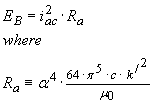 ...(14)
...(14)
Since energy must be conserved, the
energy dissipated in the radiation resistance of the loop must equal the total
energy flowing through the surface of this imaginary sphere. If we now
substitute the values for the constants we finally derive a very simple equation
for the radiation resistance of
the loop antenna
![]() ...(15)
...(15)
We can now make some
practical predictions. Let’s consider a VHF frequency of 150 MHz, which has a
wavelength of 2 meters. A very large loop might be 1/10 this wavelength, i.e. 20
cm by 20 cm. A very small loop might be ten times smaller again. Lets estimate
the radiation resistance for both extremes and for a loop of intermediate
dimensions
Radiation Resistance For Loop
Antennae at 150 MHz
|
Fractional Size |
Loop Segment Length cm |
Loop Area cm2 |
Radiation Resistance Ohms |
|
0.1 |
20 |
400 |
4.7 |
|
0.03 |
6.0 |
36.0 |
0.038 |
|
0.01 |
2.0 |
4.0 |
0.00047 |
We now see the Achilles heel of the loop antenna. As the fractional wavelength reduces, the radiation resistance quickly plummets to zero due to a forth power term. In this case the ohmic losses of the loop soon dominate.
As an estimation guide, the wire or
track segments that make up the loop will have an inductance per unit length
denoted by
![]() ...(16)
...(16)
The reactance per unit length
will be frequency dependant, i.e.
 ...(17)
...(17)
Since we defined
![]() it follows that
it follows that
![]() ...(18)
...(18)
In the absence of direct
measurement data, a well constructed small dimensioned coil can easily exhibit a
Q factor as high as 200 at VHF, and the ohmic series loss associated with the
coil, or in this case the inductive loop antenna will equal the reactance
divided by this Q,
 ...(19)
...(19)
The radiation efficiency for
small loop structures will therefore be determined by the ratio of radiation
resistance to total loop resistance, which can be expressed in dB as
![]() ...(20)
...(20)
Substituting equations () and
()
 ...(21)
...(21)
We can now approximately predict
general loop antenna radiation efficiency, using the previous example dimensions
Antenna Efficiency For Loop
Antennae at 150 MHz Expressed in dB
|
Fractional Size |
Loop Length cm |
Loop Area cm2 |
Radiation Efficiency dB |
|
0.1 |
20 |
400 |
-2.6 |
|
0.03 |
6.0 |
36.0 |
-15.0 |
|
0.01 |
2.0 |
4.0 |
-29.1 |
We immediately observe that
the expected radiation efficiency is critically dependant on size. A magnetic B
field loop antenna would generally be used when the available space for a
conventional dipole antenna was absent. Even a ¼ wave helical antenna could be
reduced to dimensions around
![]() of a wavelength, so the magnetic B
field antenna would probably be selected for fractional wavelength dimensions
far less than this. The corresponding “loss” compared to a conventional
dipole could be 29 dB or greater, depending on the size reduction needed.
of a wavelength, so the magnetic B
field antenna would probably be selected for fractional wavelength dimensions
far less than this. The corresponding “loss” compared to a conventional
dipole could be 29 dB or greater, depending on the size reduction needed.
This does not rule the
magnetic B field antenna out for all applications. It can be small, albeit
inefficient, but many applications may accept a compromise between size
convenience and radiation (or equivalent reception) efficiency.
Strategies for improving
radiation efficiency include the use of lower loss conductors (super-conductors
perhaps?) or the use of ferrite material intended to increase the B field
radiated from the loop.
What will happen if the loop has more than one turn? The B field will increase by an amount equal to the turns squared, but so too will the inductance and therefore the ohmic resistive loss.
Return To Magnetic B Field Antenna
Return To Kaleidoscope Comms